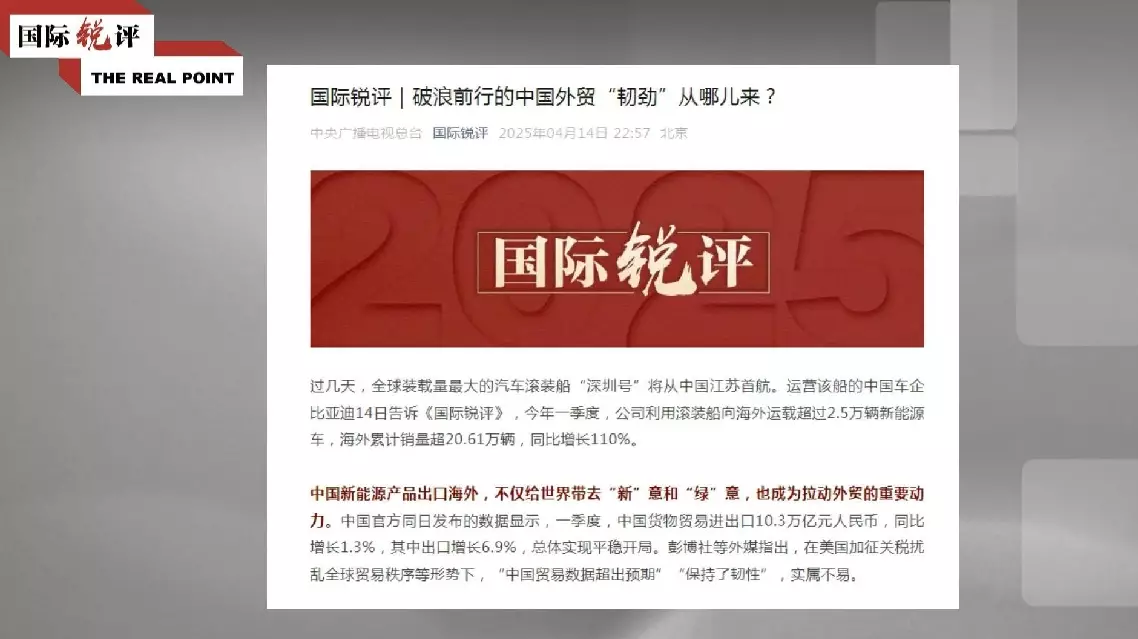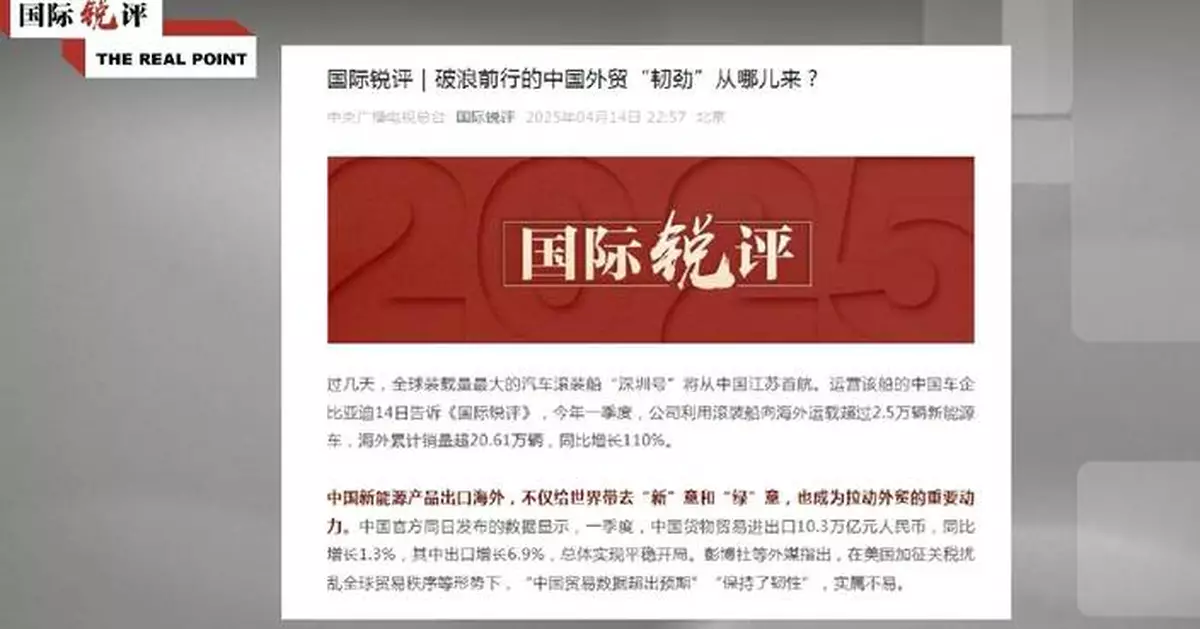Amid various external challenges, including tariff barriers, China’s foreign trade has demonstrated strong resilience in the first quarter, bolstered by solid economic fundamentals, a shift toward innovation, the implementation of a series of support policies, and other contributing factors, according to a commentary by The Real Point published on Monday.
An edited English version of the commentary is as follows:
In the first quarter, China's foreign trade got off to a stable start, with total imports and exports of goods growing by 1.3 percent year on year to reach 10.3 trillion yuan (approximately 1.43 trillion U.S. dollars), while exports rose by 6.9 percent, according to official data released on Monday.
One major driver of this growth has been China's booming new energy sector.
China's exports of new energy products have not only brought innovation and green development to the rest of the world, but also served as a key driver of the country's foreign trade growth.
In the first quarter of 2025, China's leading new energy vehicle (NEV) manufacturer, BYD Company Limited, sold a total of 206,100 new energy vehicles overseas, representing a year-on-year surge of about 110 percent.
During the three-month period, China's imports of goods declined, partly due to falling global commodity prices, and partly because the first quarter of this year had two fewer working days compared to the same period of last year.
However, what stood out was that China regisgtered rapid growth in industrial production and steady improvement in consumer demand during the first quarter, which significantly boosted imports of components, equipment and consumer goods. For instance, imports of edible oil rose by 12.1 percent, and imports of fresh and dried fruits grew by 8.3 percent, both year on year.
These trends underscore that as the world's second-largest importer, China still has vast potential for import growth, and its enormous market continues to present major opportunities for the rest of the world.
According to Wang Xiaosong, a professor with the Renmin University of China, the resilience of China's foreign trade stems from its solid economic fundamentals, vast market, significant growth potential, and the strong resilience of its industrial and supply chains.
In recent years, global supply chains have been under pressure due to escalating trade protectionism and geopolitical tensions.
Against such a backdrop, China is actively building a diversified market, which not only empowers the development of its trading partners but also enhances its own ability to withstand risks. In the first quarter of this year, the Association of Southeast Asian Nations (ASEAN) remained as China's largest trading partner, with total trade between the two sides reaching 1.71 trillion yuan (about 234.17 billion U.S. dollars), marking a 7.1 percent year-on-year increase and accounting for 16.6 percent of China's overall foreign trade.
Over the period, China's trade with the European Union rose 1.4 percent year on year. Meanwhile, China's trade with Belt and Road Initiative (BRI) partner countries grew 2.2 percent, accounting for 51.1 percent of its total foreign trade.
Despite disruptions caused by the U.S. abuse of tariffs policies, trade between China and the United States still expanded by 4 percent year on year in the first quarter, indicating a strong internal momentum that cannot be easily hindered by tariff barriers.
At the same time, the shift of China's foreign trade toward innovation has enhanced the country's competitiveness in the market. Over recent years, Chinese tech products ranging from coffee machines and robotic vacuum cleaners to electric vehicles and industrial robots have earned widespread recognition for their innovation.
In addition, the implementation of a series of policies to stabilize foreign trade has yielded tangible results, further bolstering the resilience of China's foreign trade in the face of headwinds.
Last November, the Chinese government released a set of policy measures aimed at promoting stable growth of foreign trade, including increasing financial support for foreign trade enterprises, promoting the development of cross-border e-commerce, and facilitating cross-border travel of business personnel. Adopted at an annual session of the National People's Congress in March, the government work report once again emphasized the importance of stabilizing foreign trade, and introduced a series of measures.
These efforts have helped ensure a solid start to 2025.
Foreign-invested enterprises (FIEs) have been playing an increasingly vital role in China's foreign trade.
Over the past five years, FIEs have accounted for roughly one-third of China’s total foreign trade.
In the first quarter of this year, more than 67,000 FIEs registered tangible achievements in the operation of import and export, marking the highest number for the same period in the past three years.
Meanwhile, their total foreign trade volume hit 2.99 trillion yuan (around 415.3 billion U.S. dollars), marking the fourth consecutive quarter of growth.
Since the beginning of April, the United States has imposed a new wave of so-called "reciprocal tariffs" on all its trading partners, delivering another blow to global trade.
In response to the U.S. tariff tsunami, China is accelerating the integration of domestic and foreign trade, while steadfastly expanding its opening-up.
A prime example of this openness is the recent hosting of two major trade events -- the 5th China International Consumer Products Expo (CICPE) and the 137th China Import and Export Fair (Canton Fair) -- both of which set new records in exhibition scale.
Undeterred by headwinds and challenges, China’s foreign trade continues to forge ahead with resilience. As the world watches, one thing becomes increasingly clear: protectionism leads nowhere, openness and cooperation are the ways to win the future.

China's foreign trade demonstrates strong resilience amid external challenges: commentary




















































